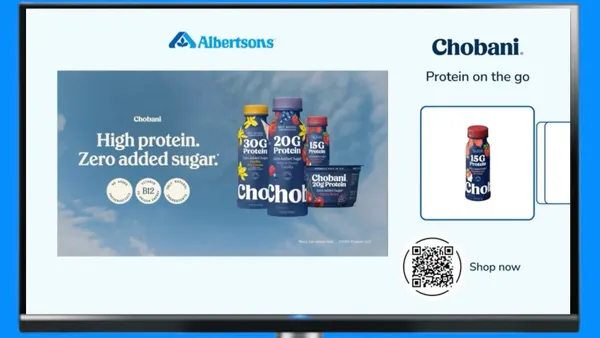Dive Brief:
- Amazon on Thursday reported that third quarter net sales rose 24% to $70 billion, as net product sales rose to $39.7 billion from $33.7 billion a year ago. In North America, its biggest market, net sales rose to $42.6 billion from $34.3 billion a year ago, according to a company press release.
- The company reported that revenue for its "other" category that mostly comes from ad sales rose 45% to $3.59 billion in Q3. Advertising grew at a rate higher than 45%, Amazon CFO Brian Olsavsky said on the earnings call.
- However, expenses rose markedly, due in large part to its ongoing effort to shorten Prime shipping to one day: Fulfillment costs alone in the quarter went to $10.2 billion from $8.3 billion in the year-ago period. As a result, profits took a hit in the quarter, with earnings declining for the first time in two years, as noted by market research firm Edge by Ascential. Net income fell to $2.1 billion from $2.9 billion a year ago, and operating income edged down to $3.2 billion from $3.7 billion last year.
Dive Insight:
The continued growth of Amazon's ad business was a bright spot in an earnings report that otherwise highlighted some weaknesses and caused the company's stock to drop on Thursday and remain down 6% in premarket trading Friday. The growth rate of more than 45% for advertising sales outpaces the first two quarters of the year, at 34% and 37%, respectively. That Q1 figure marked a deceleration from the more than 60% gains seen in the prior five quarters, and this quarter could be reversing that trend.
"It’s still early and what we’re focused on really at this point is relevancy, making sure that the ads are relevant to our customers, helpful to our customers, and to do that, we use machine learning and that’s helping us to drive better, better and better relevancy," Olsavsky said of the company's ad business on the earnings call.
On the call, Amazon's Director of Investor Relations Dave Fildes called attention to how Amazon is making it easier for advertisers to manage campaigns across its video and over-the-top streaming offering and adding more inventory through Fire TV apps.
Amazon's growth into a digital advertising giant will threaten Google and Facebook, transforming their current "duopoly" status into a "triopoly," according to a recent Forrester forecast. Ad agencies and ad-tech firms also will need to adapt as the e-commerce giant follows its long-term strategy of eliminating middlemen that hinder efficiency, according to the report.
As for Amazon's overall business, investors with a long-term view — which includes Amazon itself — cheered on the investments that stole from the bottom line, and shares were on the rise again later Friday morning.
"This is only worrisome to someone looking for quarter to quarter performance, and if they are paying attention to the logistics companies," Jon Reily, executive vice president of retail and e-commerce at Publicis Sapient, (the digital business transformation unit at Publicis Groupe), said of the profit drag.
"If your interest as an investor is the long-term health of the company there's nothing to fear here, and quite the opposite, there are many things to be happy about," he told Retail Dive in an email. "I think that the investment in 1-day shipping is expensive, $1.5 billion in Q4, but in terms of increased order value from Prime members and pressure put on other retailers to match shipping speed, it still makes it a win for Amazon no matter how expensive it is."
Several analysts cited evidence from their firms that backs up Amazon's assertion that its move to speed up delivery contributed meaningfully to topline sales in the quarter, and most expect that to continue. While Walmart, Target, Best Buy and other larger retailers are already playing effective defense by leveraging stores for their own faster fulfillment, smaller retailers may begin to lose, warned analysts at Telsey Advisory Group led by Joseph Feldman.
"Overall, Amazon continues to gain market share across retail, particularly North America," he wrote in a client note Thursday. "Importantly, the solid growth and profitability of Amazon Web Services (AWS), as well as new media and advertising offerings, should continue to outperform the company average and support investment in Retail."
On the earnings call, Olsavsky declined to elaborate on which categories are benefiting most from speedier fulfillment, saying that "broad sales across all categories" were stoked by it. That's no doubt true, though it's likely that consumer product sales were spurred the most because convenience is so closely tied to such purchases, experts said.
Spilling the tea on which categories are dominating would be all too valuable to Walmart and even to suppliers, according to Edge by Ascential Senior Analyst Jack O'Leary. While the company doesn't have metrics yet, O'Leary said he thinks "all categories are seeing lift."
"But, we do believe the biggest growth rates are being seen in smaller, more commoditized consumables versus one-time, high-consideration purchases," he told Retail Dive in an email, adding that low-cost household items are likely performing well. "Some shoppers are more likely to consider a stick of deodorant on Amazon now that they can get it in one day versus two."
The long view isn't necessarily limited to Amazon's prospects in retail. Reily believes that the fulfillment infrastructure buildup that is gobbling up profits and spurring revenue will ultimately reach a capacity that will allow Amazon to compete with third-party shippers.
On the call, Olsavsky demurred when asked about that, but described the expansion of the company's logistics capacity, including a 20% increase in employment that's going mostly to fulfillment and transportation, as "a drastic change to the whole network topology."
"There is more going on here than just shipping speed," Reily said. "Amazon is quietly building a logistics company for itself while disguising it as faster shipping, and when it's perfect they'll sell that capacity to others. That's the long-term goal here in my opinion."














